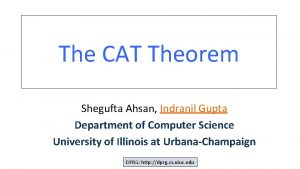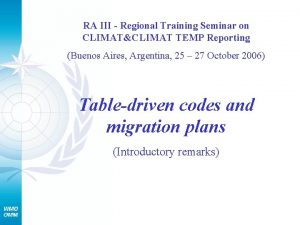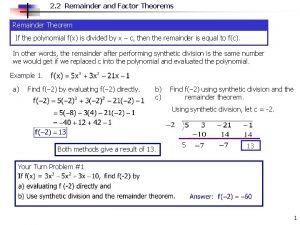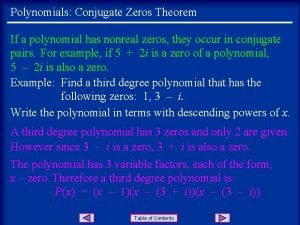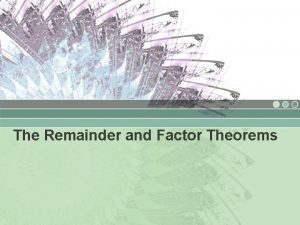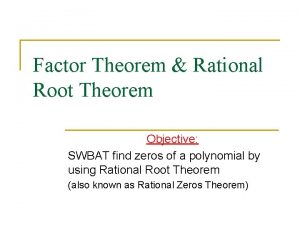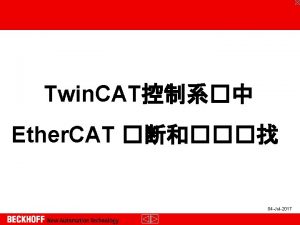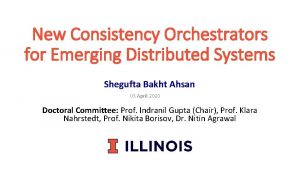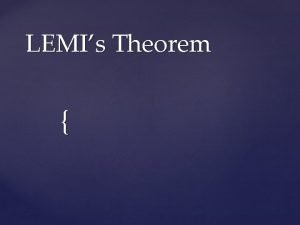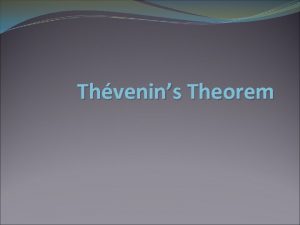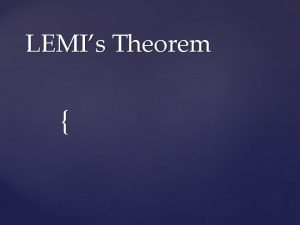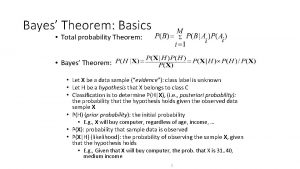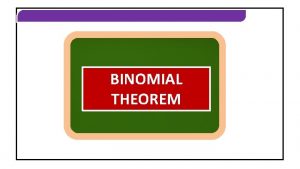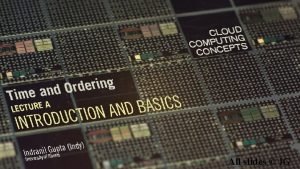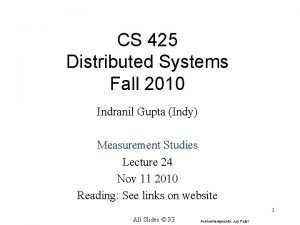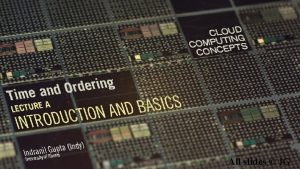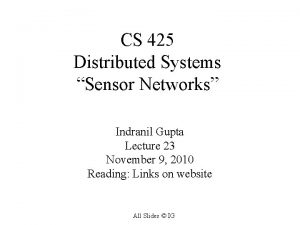The CAT Theorem Shegufta Ahsan Indranil Gupta Department



![CAP Theorem [Brewer 00, Gilbert&Lynch 02] • Starting point for No. SQL Revolution • CAP Theorem [Brewer 00, Gilbert&Lynch 02] • Starting point for No. SQL Revolution •](https://slidetodoc.com/presentation_image/2dea1db41548e47b4367f3791e71a99a/image-4.jpg)







![CAT Theorem “Proof” [Gray et al 96] C – Contention A – Abort Rate CAT Theorem “Proof” [Gray et al 96] C – Contention A – Abort Rate](https://slidetodoc.com/presentation_image/2dea1db41548e47b4367f3791e71a99a/image-12.jpg)




![Systems Chosen for Validation 1. Yesquel [Microsoft Research/VMWare SOSP 2015] 2. Amazon RDS 3. Systems Chosen for Validation 1. Yesquel [Microsoft Research/VMWare SOSP 2015] 2. Amazon RDS 3.](https://slidetodoc.com/presentation_image/2dea1db41548e47b4367f3791e71a99a/image-17.jpg)

















- Slides: 34

The CAT Theorem Shegufta Ahsan, Indranil Gupta Department of Computer Science University of Illinois at Urbana-Champaign DPRG: http: //dprg. cs. uiuc. edu

Contributions • A new impossibility theorem ``CAT’’ for transaction-based distributed databases • C – Contention • A – Abort Rate • T – Throughput • Experimental Validation with 3 databases • 1 New. SQL • 2 Traditional RDBMs 2

No. SQL database systems • Apache Cassandra, Riak, Dynamo, Voldemort… • Basic CRUD operations • Create, Read, Update, Delete • Low latency • High availability • Weak consistency 3
![CAP Theorem Brewer 00 GilbertLynch 02 Starting point for No SQL Revolution CAP Theorem [Brewer 00, Gilbert&Lynch 02] • Starting point for No. SQL Revolution •](https://slidetodoc.com/presentation_image/2dea1db41548e47b4367f3791e71a99a/image-4.jpg)
CAP Theorem [Brewer 00, Gilbert&Lynch 02] • Starting point for No. SQL Revolution • A distributed storage system can achieve at most two of C, A, and P. • Consistency – all nodes see same data/updates in order • Availability – all reads/writes succeed Consistency HBase, Hyper. Table, Big. Table, Spanner RDBMSs (non-replicated) • Partition tolerance – C and A even under partitions • When partition-tolerance is important, you have to choose between consistency and availability • PACELC Variant [Abadi 12]: under partitions, choose between latency and consistency Partition-tolerance Availability Cassandra, Riak, Dynamo, Voldemort 4

New Consistency Models and New CAPs Causal Eventual Red-Blue Per-key sequential Probabilistic CRDTs Strong (e. g. , Sequential) • Since “eventual” No. SQL systems emergence, many have strengthened consistency while maintaining throughput • In SOSP 2015: Six papers supporting ACID with high throughput • Yesquel [Microsoft Research/VMWare], Tapir [U. Washington], Callas [U. Texas. Austin] • Fa. RM [Microsoft Research], RIFL [Stanford], Dr. TM [SJTU] • (Others: Hyperdex [Cornell]) • Some researchers say CAP theorem invalid • Others say “P” in CAP should = “Performance” (Throughput) 5

CAP Alive, Impractical • CAP theorem is true, formally proved • There is a gap between the CAP theorem and the practical needs of today’s systems • Partitions are relatively rare • Availability is a fuzzy term • Need for a new theorem that captures performance limitations of ACID systems • Our CAT Theorem 6

C – Contention A – Abort Rate T – Throughput CAP vs CAT CAP CAT Consistency Contention Availability Abort Rate Partition Tolerance Throughput 7

CAT Definitions • Contention: How much transactions overlap with each other • Abort Rate : Fraction of submitted transactions that are aborted • Throughput: Committed Transactions Per Second (TPS) 8

CAT Definitions (And Analogies to CAP) • Contention: How much transactions overlap with each other • Strongly consistent (Zero contention): • Immutable No. SQL System • ACID System supporting only read-only transactions • Abort Rate : Fraction of submitted transactions that are aborted • From client viewpoint: Transaction Abort in ACID ≅ Unavailability for a CRUD op in No. SQL • Throughput: Committed Transactions Per Second (TPS) 9

CAT Theorem No transactional database can support arbitrarily high levels of contention while yielding both a zero abort rate as well as high throughput. (Or: Can’t get all 3 of C, A, T) (CAT theorem does not replace, but sits alongside CAP theorem) 10

Some Simple CAT Scenarios C – Contention A – Abort Rate T – Throughput • Scenario-I (C and A): Executing one transaction at a time (zero contention) zero Abort rate, but low Throughput • Scenario-II (C and T): Executing all transactions concurrently high Throughput, but increases the Abort rate • Scenario-III (A and T): Immutable database/Read-only transactions both high Throughput and zero Abort rate 11
![CAT Theorem Proof Gray et al 96 C Contention A Abort Rate CAT Theorem “Proof” [Gray et al 96] C – Contention A – Abort Rate](https://slidetodoc.com/presentation_image/2dea1db41548e47b4367f3791e71a99a/image-12.jpg)
CAT Theorem “Proof” [Gray et al 96] C – Contention A – Abort Rate T – Throughput • When there is contention across transactions, the abort rate increases at least as • Square of the throughput of the system • Third to fifth power of transaction size 12

Measurements 13

C – Contention A – Abort Rate T – Throughput Measuring Contention • Our “Contention Level” metric • For a set of concurrent transactions • Common Objects are those objects that are accessed by at least 2 transactions in a set of concurrent transaction • Contention Level = (total accesses to common objects) / (total number of accesses) • Lies in [0, 1] 14

C – Contention A – Abort Rate T – Throughput Measuring Contention Example: • Three concurrent transactions: • T 1 = {obj 1, obj 2, obj 3} • T 2 = {obj 4, obj 2, obj 5} • T 3 = {obj 5, obj 6, obj 7} • Total number of common object accesses: 4 • Total number of objects accessed: 9 • Contention Level = 4/9 = 0. 44 15

Contention Level Vs. • Vs. Jim Gray’s contention metric (Equation 1, works for Uniform Distribution only) Contention Level vs Simulated Abort Rate • Vs. Real abort probability (based on serial equivalence rules) • Not exact, but parallel trend Contention Level • Overestimates abort rate Sanity Point 0. 1 Reference Line (x=y) Linear(Sanity Point) 0. 08 0. 06 0. 04 0. 02 0 0 0. 01 0. 02 0. 03 0. 04 0. 05 Abort Rate of Brute-force Simulation 0. 06 16 0. 07
![Systems Chosen for Validation 1 Yesquel Microsoft ResearchVMWare SOSP 2015 2 Amazon RDS 3 Systems Chosen for Validation 1. Yesquel [Microsoft Research/VMWare SOSP 2015] 2. Amazon RDS 3.](https://slidetodoc.com/presentation_image/2dea1db41548e47b4367f3791e71a99a/image-17.jpg)
Systems Chosen for Validation 1. Yesquel [Microsoft Research/VMWare SOSP 2015] 2. Amazon RDS 3. Microsoft SQL 4. (Fail: Tapir) 5. (Fail: Hyperdex) 6. (Unavailable: Callas) 17

Experimental Setup • Yesquel : All experiments were run on Emu. Lab cluster (3 servers, up to 7 clients). • We wrote a benchmarking tool in C++ (similar to YCSB+T) • MS Azure SQL, Amazon RDS : publicly available APIs were used. • We wrote the same benchmarking tool (YCSB+T) in C# and Java • Database contained total 1000 keys, total 10 K transactions • Clients continuously send transactions one at a time 18

Variables • η = length of the transaction • η = 4 → { perform transaction on keys a, b, c, d} • η = 8 → { perform transaction on keys a, b, c, d, e, f, g, h} • α = Zipfian co-efficient. Higher value means some objects more popular. α = 0. 1, Total keys = 10 Total calls = 1000 α = 0. 9, Total keys = 10 Total calls = 1000 19

C – Contention A – Abort Rate T – Throughput Y = Yesquel, A = AWS RDS, M = MS SQL Abort Rate (WR, Y) Abort Rate (W, A) Abort Rate (W, M) Normalized Avg TPS (WR, Y) Normalized Avg TPS (W, A) Normalized Avg TPS (W, M) 0. 8 0. 6 0. 4 0. 2 0 1 2 3 4 Number of Clients 5 6 7 Write Only Aggregate Throughput 1 Contention Level 50% Read, 50% Write 1000 800 600 400 200 0 1 2 3 4 Number of Clients 5 6 7

C – Contention A – Abort Rate T – Throughput Y = Yesquel, A = AWS RDS, M = MS SQL Abort Rate (WR, Y) Abort Rate (W, A) Abort Rate (W, M) Normalized Avg TPS (WR, Y) Normalized Avg TPS (W, A) Normalized Avg TPS (W, M) 0. 8 0. 6 0. 4 Write Only Aggregate Throughput 1 Contention Level 50% Read, 50% Write 1000 800 600 400 200 0 1 0. 2 2 3 4 Number of Clients 5 6 7 0 1 2 3 4 Number of Clients 5 6 7 As Contention Increases Abort Rate Rises Aggregate Throughput Rises 21

C – Contention A – Abort Rate T – Throughput Y = Yesquel, A = AWS RDS, M = MS SQL Abort Rate (WR, Y) Abort Rate (W, A) Abort Rate (W, M) Normalized Avg TPS (WR, Y) Normalized Avg TPS (W, A) Normalized Avg TPS (W, M) 0. 8 0. 6 0. 4 0. 2 Write Only Aggregate Throughput 1 Contention Level 50% Read, 50% Write 1000 800 600 400 200 0 1 2 3 4 Number of Clients 5 6 7 CA Scenario: 1 Client only = No Contention Zero Abort rate But Lowest Aggregate Throughput 6 7

C – Contention A – Abort Rate T – Throughput Y = Yesquel, A = AWS RDS, M = MS SQL Abort Rate (WR, Y) Abort Rate (W, A) Abort Rate (W, M) Normalized Avg TPS (WR, Y) Normalized Avg TPS (W, A) Normalized Avg TPS (W, M) 0. 8 0. 6 0. 4 0. 2 Write Only Aggregate Throughput 1 Contention Level 1000 800 600 400 200 0 1 2 3 4 Number of Clients 5 6 50% Read, 50% Write 7 With Rising Contention Per-client Throughput Decreases 5 6 7

C – Contention A – Abort Rate T – Throughput Y = Yesquel, A = AWS RDS, M = MS SQL Abort Rate (WR, Y) Abort Rate (W, A) Abort Rate (W, M) Normalized Avg TPS (WR, Y) Normalized Avg TPS (W, A) Normalized Avg TPS (W, M) 0. 8 0. 6 0. 4 0. 2 Write Only Aggregate Throughput 1 Contention Level 50% Read, 50% Write 1000 800 600 400 200 0 1 2 3 4 Number of Clients 5 6 7 MS SQL > AWS RDS (>? Yesquel): Surprising(? ) 6 7

C – Contention A – Abort Rate T – Throughput Zero Contention (AT Scenario, Yesquel) • All Read-only transactions → zero Abort rate • Increasing number of clients → Throughput rises linearly • When there is no contention, there are no aborts and throughput rises linearly 25

Y = Yesquel A = AWS RDS M = MS SQL Effect of Transaction Overlap • Contention can also be increased by • Increasing transaction “overlap” • Increasing Zipf Coefficient (α): • Increases Contention Level • Increases Abort Rate • Decreases Throughput 26

Y = Yesquel A = AWS RDS M = MS SQL Effect of Transaction Length η • Contention can also be increased by • Increasing transaction length • Result – same as before: • Increases Contention Level • Increases Abort Rate • Decreases Throughput 27

Takeaways • Transactional databases don’t mesh with CAP Theorem • Our new CAT Theorem states new, practical, impossibility • Cannot support high Contention, and achieve zero Aborts, and high Throughput, all at once. • Inspired by Jim Gray’s paper • New Contention Level metric • Validated with a New. SQL System (Yesquel) and 2 traditional RDBMSs (AWS RDS, MS SQL) • Further Directions: • CAP-like variants for transactional systems • Interplay of CAP and CAT theorems • CAT applied to transactional shared-memory models DPRG: http: //dprg. cs. uiuc. edu 28

Backup Slides 29

Summary • A new impossibility theorem ``CAT’’ for transaction-based distributed databases : • No transactional database can support arbitrarily high levels of contention while yielding both a zero abort rate as well as a high throughput • CAT sits alongside the classical CAP and its variants • We propose a new Metric to measure the contention in a system 30

CAT Theorem No transactional database can support arbitrarily high levels of contention while yielding both a zero abort rate as well as a high throughput Jim Gray 1996: : The dangers of replication and a solution 31

New. SQL systems • Modern relational database management systems • Provide the same scalable performance of No. SQL • Supports Online Transaction Processing (OLTP) • Maintains ACID guarantees • • Atomicity Consistency Isolation Durability 32

CAP-No. SQL Vs CAT-New. SQL • CAP – originally intended for CRUD supporting No. SQL system • CAT – intended for transactional/New. SQL system • “abort” in New. Sql ↔ “unavailability” in No. SQL • Contention across transaction is an important factor • In CRUD, an immutable system supports strong consistency • In transactional system, if all transactions are read-only, there will be no abort 33

Our Contribution • Transactional-based distributed database (New. SQL) systems need a more practical version of a CAP-like impossibility theorem • One that is focused on realistic metrics: • Abort rate • Throughput • We propose the CAT impossibility theorem • C – Contention • A – Abort Rate • T – Throughput • We propose a new Metric to measure the contention in a system 34
 Ccontention
Ccontention Cat 1 cat 2 cat 3 aviation
Cat 1 cat 2 cat 3 aviation Cat 1 2 3 minima
Cat 1 2 3 minima Ahsan mehanti
Ahsan mehanti Professor dr. h a m nazmul ahsan
Professor dr. h a m nazmul ahsan Ahsan ali syed
Ahsan ali syed Prof. dr. qumrul ahsan
Prof. dr. qumrul ahsan Sudden painless loss of vision
Sudden painless loss of vision Stokes theorem is relation between
Stokes theorem is relation between I bought me a cat and the cat pleased me
I bought me a cat and the cat pleased me Remainder theorem
Remainder theorem Linear factors theorem and conjugate zeros theorem
Linear factors theorem and conjugate zeros theorem State remainder theorem
State remainder theorem Linear factors theorem and conjugate zeros theorem
Linear factors theorem and conjugate zeros theorem Factor theorem
Factor theorem The remainder theorem
The remainder theorem Các môn thể thao bắt đầu bằng tiếng bóng
Các môn thể thao bắt đầu bằng tiếng bóng Hình ảnh bộ gõ cơ thể búng tay
Hình ảnh bộ gõ cơ thể búng tay Sự nuôi và dạy con của hươu
Sự nuôi và dạy con của hươu điện thế nghỉ
điện thế nghỉ Dot
Dot Thế nào là sự mỏi cơ
Thế nào là sự mỏi cơ độ dài liên kết
độ dài liên kết Trời xanh đây là của chúng ta thể thơ
Trời xanh đây là của chúng ta thể thơ Chó sói
Chó sói Thiếu nhi thế giới liên hoan
Thiếu nhi thế giới liên hoan Vẽ hình chiếu vuông góc của vật thể sau
Vẽ hình chiếu vuông góc của vật thể sau Một số thể thơ truyền thống
Một số thể thơ truyền thống Thế nào là hệ số cao nhất
Thế nào là hệ số cao nhất Frameset trong html5
Frameset trong html5 Hệ hô hấp
Hệ hô hấp Bảng số nguyên tố lớn hơn 1000
Bảng số nguyên tố lớn hơn 1000 đặc điểm cơ thể của người tối cổ
đặc điểm cơ thể của người tối cổ Các châu lục và đại dương trên thế giới
Các châu lục và đại dương trên thế giới Cách giải mật thư tọa độ
Cách giải mật thư tọa độ
